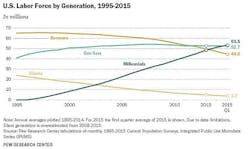Is your workplace getting decidedly younger? If so, you’re part of a massive influx of millennials into U.S. companies. According to a Pew Research Center study, millennials (ages 18 to 34 in 2015) surpassed Generation X this year to become the biggest part of the workforce with 53.5 million employed. And as younger millennials enter the workforce in the next few years, that number will continue to rise.
Employers (none more so than manufacturers) want to entice this fresh corps of talent to their companies but the road has not always been smooth. Two leadership authorities are betting that Peter Drucker can help.
Frances Hesselbein is the recipient of 22 honorary doctoral degrees, the former CEO of the Girl Scouts of the USA and a recipient of the Presidential Medal of Freedom. She now heads the Frances Hesselbein Leadership Institute, formerly the Peter F. Drucker Foundation for Nonprofit Management. Joan Snyder Kuhl is on the institute’s board and is founder of Why Millennials Matter, a consulting company based in New York City that focuses on raising employer awareness of the future workforce. Together, they have released an enhanced edition of Peter Drucker’s Five Most Important Questions: Enduring Wisdom for Today’s Leaders (Wiley).
Hesselebein and Kuhl believe that Drucker’s five questions not only can help younger leaders bring clarity and purpose to their organizations and their own actions but also serve as a kind of bridge between the generations.
“The war for global talent is in full swing,” Kuhl writes in the book’s introduction. “Executives and organizations in every sector are looking for strategies to amplify the productivity of their younger workforce and grow their skills toward sustainable leadership.”
For those who haven’t been exposed to them previously, Drucker’s five questions form the backbone of an organizational self-assessment process and are:
- What is our mission? “The mission says why you do what you do, not the means by which you do it,” Drucker wrote.
- Who is our customer? Drucker defined a customer as someone who “values your service, who wants what you offer, who feels it’s important to them.”
- What does the customer value? Drucker wrote it was essential not to guess at what customers want. Instead, he said leadership “should always go to the customers in a systematic quest for those answers.”
- What are our results? Drucker said organizations need to define results, determine what needs to be strengthened or abandoned, and hold leadership accountable for ensuring meaningful results.
- What is our plan? The plan, Drucker wrote, “encompasses mission, vision, goals, objectives, action steps, a budget, and appraisal.” He advocated for no more than five goals. Any more and “You’re simply spreading yourself too thin.”
Some soul searching on what your company does and why seems particularly timely as millennials stream into the workplace and older managers seek to integrate them into their organizations. Kuhl says managers are constantly telling her that millennials “communicate differently and that they are having challenges in engaging them and unleashing their productivity.”
What Drives Millennials?
Part of the problem may be the belief that millennials are a self-centered, pampered generation driven by money and status. In fact, it’s just the opposite, says Kuhl.
“They are actually driven by making a difference, seeing that they have a contribution to a larger purpose, not just a siloed individual role,” she told IndustryWeek.
Kuhl noted that she had visited 20 schools recently to speak with students. “They are so intent on feeling a part of something changing the world,” she explained. “That’s because they are the first global generation. They grew up with the internet. They grew up knowing about problems that were outside of their neighborhood. They saw that they could use their time, whether on spring break or volunteering, to give back and how that feels good. It’s like mentoring. No matter how much you give, you get back so much more.”
Many companies are seeking to align their missions with global issues such as energy conservation or potable water availability. That offers managers a great opportunity to connect with millennials. But helping millennial hires to understand the mission and culture of a company is one area where companies often miss the boat, say Hesselbein and Kuhl.
“Companies large and small, when they onboard young talent, it’s a very general presentation about the history of the company and their benefits,” says Kuhl. “There is such a huge opportunity to get them right away to understand what the business model is, really be exposed in an interactive way to what the leadership sees as the vision of the future.”
As millennials seek to integrate this broader vision of their lives with the demands of a new job, it can be very challenging, says Kuhl. That’s why companies need to provide them a steady stream of information and help them understand what the company and its products do for the community at large.
Kuhl adds that mentoring young employees does not have to be a crushing task for time-pressed managers in leaner organizations.
“They think it is going to be this overwhelming process where you have to adopt them like a mother or father,” Kuhl observes. “It’s really just a conversation here or there. When you have somebody new in your department, you just ask everybody on your team to spend 5 minutes to get to know them.”
Hesselbein says this generation is more comfortable with a management structure that is “circular,” not the hierarchical “up down, top bottom” structure that she pronounces “dead.” She says this more collaborative organization facilitates more diverse thought and promotes innovation.
Collaboration is not a substitute for management direction, however. Kuhl says millennials require more direction than earlier generations but also “more flexibility and more air cover to make mistakes.”
“We forget how much of a lens is on everyone these days with social media and the internet,” Kuhl points out. “They grew up with very specific directions on how to get the A, how to get into college, how to get your resume together. That is why they get overwhelmed.”
The leadership sweet spot for this generation is to provide them the framework for what you need and make sure they know what “good looks like,” says Kuhl, but also give them the latitude to use the problem-solving skills that come with a life connected to the internet.
“I have seen too often where management has this idea in their head of how they expect the work to be done. When somebody comes back and doesn’t do it that way, they tell them it is wrong but they don’t tell them exactly what is wrong or they don’t want them going outside a very strict boundary of ideas,” she says.
Using Drucker’s five questions is a great starting point for any company that wants to better understand its mission and, by extension, communicate that mission to its workforce, young and old.
“Peter always said a mission should fit on a T-shirt,” says Hesselbein. “There is something about having a short, powerful, passionate mission that attracts millennials.”





